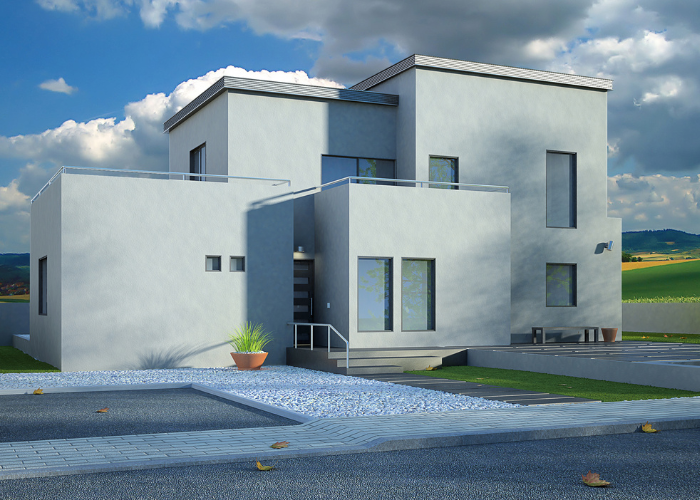Advancements in artificial intelligence (AI) have disrupted several industries. From content creation to photography and video editing to graphic design, it has made work faster, cheaper, and easier.
But what is AI’s place in real estate? Are there certain benefits you can derive from employing this innovative technology or is it just hype?
Artificial intelligence is challenging the status quo and pushing boundaries by allowing non-designers to create renders from scratch. All users have to do is type in what they need or use a 2D sketch as a foundation.
Join Plus Render as we navigate the benefits, drawbacks, and applications of AI-rendered images.
What Are AI Renderings?
Artificial intelligence renderings use machine-learning algorithms to bring your vision to life. Unlike traditional architectural renderings, they don’t rely on computational power to generate life-like visuals. Users can generate high-quality images in a fraction of the time it used to take.
This can speed up feedback and approval. It also leaves professionals free to sharpen their creativity and experiment with more innovative designs.
In addition, it can be readily integrated with technologies like Augmented Reality (AR) and Virtual Reality (VR) for creating engaging, hyper-realistic environments.
AI renderings bridge the gap between the digital and physical worlds by allowing prospects to get up close and personal with the structure. Clients can explore these simulated environments as if they were inside. This allows them to see how structures fit into their surrounding environments even before construction begins.
Benefits of Using AI to Render Architectural Images
Artificial Intelligence uses vast amounts of real-time data to:
- Automate mundane and repetitive tasks.
- Test designs in various weather conditions
- Offer unmatched accuracy for measurements and scale
- Enable more efficient resource allocation while reducing waste
- Suggest modifications to ensure superior performance and efficiency
- Identify system failures and structural integrity issues before they lead to a loss of resources, accidents, and deaths
The best thing is image elements can be tweaked in real time!
Human Expertise Is Still Irreplaceable
AI-rendered images can only supplement visualizations made by companies like Plus Render, not replace them. Take a look at how skilled human intervention can make all the difference in this competitive biz:
Enhanced Visual Communication
AI can produce realistic experiences, but it cannot account for the complexities of design. It’s not as detailed, which can give it a rather fake appearance upon closer inspection.
Artists, on the other hand, can simulate the effect of different types of light, creating drama, setting the mood, and influencing the perception of the space. They can also provide insights into the characteristics of the materials used and how they affect performance and efficiency.
Non-AI images provide stakeholders with clear, understandable visuals that convey the look and feel of the proposed design. They can enhance project understanding and increase confidence, which can help secure buy-in.
Highly Personalized
Artificial Intelligence may be the ultimate disrupter in other fields, but it lacks the creativity, innovation, and innate understanding of human emotions that take architectural design from good to great.
It’s getting more realistic every day; there’s no denying that. But AI is still limited to its programming parameters so there are certain needs it cannot meet.
Plus, it’s restricted by the amount and quality of data it is fed. Since this data is shared across the software, even your competitors will have it.
What this means is there’s very little chance of originality. And that’s where architectural renderings reign supreme.
Artists use their skills, integrate styles they’ve developed over the years, and consider the human experience. They explore how designs affect people physically, socially, and emotionally as they turn houses into homes.
Improved Design Process
Not all of your innovative ideas will turn out to be practical and functional. Unfortunately, this realization is often made after construction has started.
Architectural renderings show the design from every angle while offering insane clarity and attention to detail that artificial intelligence cannot match. This allows you to validate the design while detecting and addressing potential issues early on so they don’t sneak into production.
Unparalleled Creativity
The creativity of AI is restricted to its programming. Though it can come up with many aesthetically pleasing and functional designs, it’s no match for the limitless potential of human creativity.
Unlike AI, humans can think outside the box, exercise creative problem-solving, and come up with ideas that haven’t been conceived.
AI-generated images are the result of science. For humans, architecture is an art that represents personal artistic vision.
Exploring Potential Applications for AI in Architecture
Though AI-rendered images have their shortcomings, they can still serve certain purposes. Here’s a look at some areas where it can be an immense help:
Create Structures With 3D Printing
3D printing technology has changed the real estate landscape. It has advanced to a point where it can create full-fledged, functional homes!
AI-controlled 3D printers can rapidly produce precise three-dimensional prototypes of apartments, buildings, and structural complexes. This helps with assessing the structural integrity and aesthetics of a space while allowing real estate professionals to create a lasting impression.
Draft Documentation
AI can minimize the manual labor involved in extracting information from contracts, invoices, receipts, and more. It automatically generates relevant, accurate, and complete documentation. Ultimately, AI has the ability to revolutionize data management while reducing the hours spent on such processes by 30% to 40%.
Create Parametric Designs
From the Heydar Aliyev Cultural Center to the Serpentine Pavilion, parametric designs are rewriting the rules of architecture, design, and construction.
With AI, you can program algorithmic processes that respond dynamically to changing parameters and push the boundaries of the imagination. It can help create innovative, customized structures that would have otherwise been too complex or time-consuming for humans to design.
Automate the Production of Virtual Tours
AI can be used to create new ways of developing, displaying, and experiencing virtual tours. Image generators that rely on AI use natural language processing systems and holography techniques to produce simulations that have a certain degree of realism. Instead of using stitching software and special cameras, they create 360-degree images based on descriptive text.
Get Regulatory Assistance
Architects and designers are required to check the compliance of design models in realistic environments. Leveraging data analysis using AI can make the process faster, more efficient, and more reliable.
It can be used to ensure compliance with zoning laws and building codes. This helps improve the user experience while helping real estate professionals meet project goals and requirements.
Produce Images for Marketing
AI can also be used to create high-quality images that can be used in marketing collaterals. Users can quickly generate visually appealing images for websites, social media campaigns, brochures, and flyers.
These can attract potential investors and buyers.
Improve Urban Planning
Urban planning can be multidimensional and highly complex because the dynamics of cities are continuously changing. Developing and designing solutions requires great effort. Multiple factors need to be considered such as population trends, the area’s environment and climate, and the needs of its residents.
With the help of generative AI, professionals can offload repetitive tasks and identify optimal routes for utilities. They can also predict and analyze air quality and energy efficiency to guide informed decision-making.
Assist with Education and Training
Imagery is a highly effective tool for education and training. Instead of scrambling for images that illustrate different architectural principles, educators can quickly generate the necessary images.
Realistic examples can highlight the principles of design, architectural history, and techniques in construction.
Preserve Historical Structures
Some buildings are so historic that they must be preserved. Instead of spending weeks and even months reimagining what the original structure looks like, architects can use AI to produce accurate visualizations that greatly aid the reconstruction process.
The same technology can also help architects evaluate the impact of their reconstruction projects, empowering them to execute and preserve buildings with superior results.
Speed Up Sketching and Ideation
The groundbreaking technology can change how architects approach sketching and concept generation. There’s no need to go back to paper and pencil, which can take hours and even months to design.
Professionals can use Generative Adversarial Networks (GANs) in the iterative design processes to generate a collection of ideas based on parameters like location, size, and the needs of the client.
Plus Render Combines Technology With Human Ingenuity
AI-rendered images are an excellent way to bring your artistic vision to life. They’re faster to create while being cheap and easy to use. However, they face certain limitations, mainly because of their limited programming.
The best course of action is to use the innovative technology and combine it with human experiences, ingenuity, and empathy. Plus Render blends machine intelligence with human talent. Our experts use technology to fast-track certain processes and deliver the best results, however, we’re still guided by human sensitivities that the best AI solutions have yet to harness.
Commission architectural renderings that feature the best of technology and human expertise with Plus Render. Book a call today for cutting-edge architectural visualizations.







